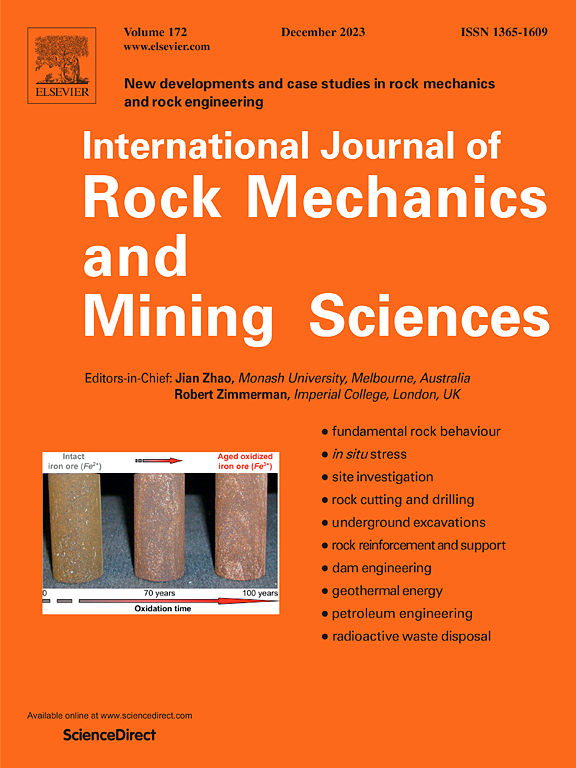水耦合爆破与空气耦合爆破的破岩特性差异
IF 7
1区 工程技术
Q1 ENGINEERING, GEOLOGICAL
International Journal of Rock Mechanics and Mining Sciences
Pub Date : 2024-09-27
DOI:10.1016/j.ijrmms.2024.105924
引用次数: 0
摘要
水耦合爆破(WCB)技术因其高效、环保等优点受到广泛关注。然而,在实际工程中,水煤浆爆破的参数一般都是根据空气耦合爆破(ACB)的经验和标准确定的,导致爆破效果不佳和爆炸能量的浪费。本研究重点比较了 WCB 和 ACB 的冲击波和爆炸气体的破岩效果,为优化 WCB 的设计提供启示。首先,计算了不同耦合介质爆破时的应力场。然后,分析了 WCB 和 ACB 之间岩石的冲击破坏特征。结果表明,随着 WCB 和 ACB 去耦系数的增大,冲击破坏区的半径会减小。在此基础上,提出了计算 WCB 和 ACB 冲击破坏范围的模型。该模型可用于估算两种爆破中细粒石材的比例。此外,还根据爆破破坏的数值模拟结果,提出了一种区分冲击波和爆炸气体破岩效果的方法。对 WCB 和 ACB 在冲击波和气体作用下的岩石破坏量进行了比较分析。结果表明,在 WCB 中,冲击波和气体诱发的岩石破坏体积是 ACB 的 1.4-2.1 倍,解耦系数在 1.26-1.71 之间。最后,讨论了一种确定 WCB 中装药结构的方法,该方法已通过现场试验得到初步验证。这些发现有助于通过合理选择耦合介质和装药结构来调节爆破中的破岩效果。本文章由计算机程序翻译,如有差异,请以英文原文为准。
Difference in rock-breaking characteristics between water-coupling blasting and air-coupling blasting
The water-coupling blasting (WCB) technology has received widespread attention due to its advantages of high efficiency and environmental protection. However, the parameters of WCB in practical engineering are generally determined based on the experience and standards of air-coupling blasting (ACB), leading to poor blasting effects and wastage of explosive energy. The study focuses on comparing the rock-breaking effects of shock waves and explosive gases between WCB and ACB to offer insights for optimizing the design of WCB. Firstly, the stress field in blasting with different coupling mediums was calculated. Then, the shock failure characteristics of rocks between WCB and ACB were analyzed. The results show that the radius of shock failure zones decreases with the increasing decoupling coefficient in WCB and ACB. On this basis, a model for calculating the shock failure range in WCB and ACB was proposed. This model can be utilized to estimate the percentage of fine-grained stone in the two types of blasting. Further, a method for distinguishing between the rock-breaking effects of shock waves and explosive gases was proposed based on the numerical simulation results of blasting damage. A comparative analysis between WCB and ACB on the rock-breaking volume by shock waves and gases was conducted. The results indicate that the failure volumes of rocks induced by shock waves and gases in WCB are 1.4–2.1 times greater than those in ACB, with a decoupling coefficient ranging from 1.26 to 1.71. Finally, a method for determining the charging structure in WCB was discussed, which has been preliminarily validated by field tests. The findings can help regulate rock-breaking effects in blasting by rationally selecting coupling mediums and charging constructions.
求助全文
通过发布文献求助,成功后即可免费获取论文全文。
去求助
来源期刊
CiteScore
14.00
自引率
5.60%
发文量
196
审稿时长
18 weeks
期刊介绍:
The International Journal of Rock Mechanics and Mining Sciences focuses on original research, new developments, site measurements, and case studies within the fields of rock mechanics and rock engineering. Serving as an international platform, it showcases high-quality papers addressing rock mechanics and the application of its principles and techniques in mining and civil engineering projects situated on or within rock masses. These projects encompass a wide range, including slopes, open-pit mines, quarries, shafts, tunnels, caverns, underground mines, metro systems, dams, hydro-electric stations, geothermal energy, petroleum engineering, and radioactive waste disposal. The journal welcomes submissions on various topics, with particular interest in theoretical advancements, analytical and numerical methods, rock testing, site investigation, and case studies.

 求助内容:
求助内容: 应助结果提醒方式:
应助结果提醒方式:


